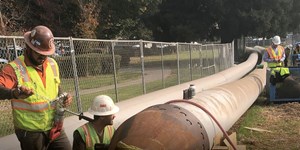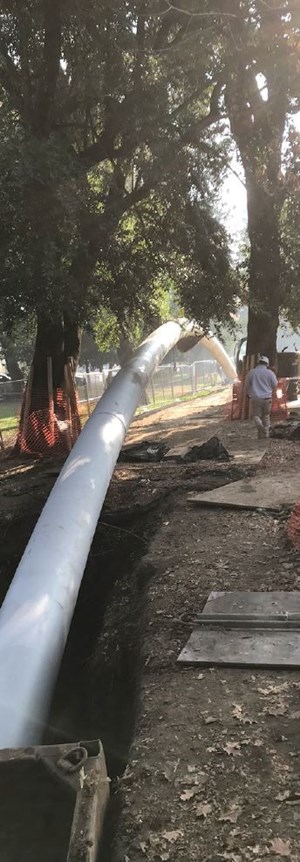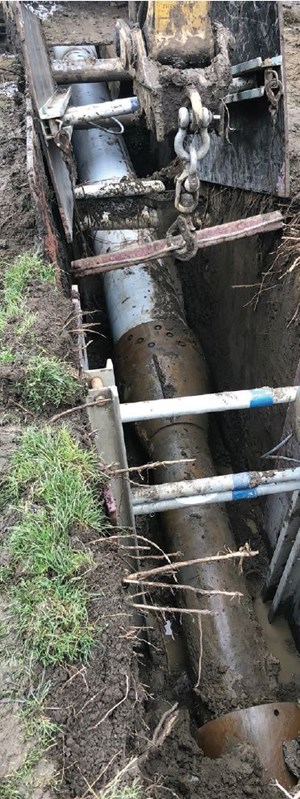February 2019 Vol. 74 No. 2
Features
Pipe Bursting Solution from Inside Park
By Jeff Griffin | Senior Editor
Utility owners, their engineers and planners, and consulting engineers can employ a variety of trenchless construction and rehabilitation methods today, selecting one or several best suited for a project’s specific requirements.
In California’s San Francisco Bay Area, the Ross Valley Sanitary District faced several challenges on a project to rehabilitate or replace aging sanitary sewer infrastructure.
One segment of a large diameter sewer main was in the town of Ross and was located under Ross Commons Park and adjacent downtown areas. It included replacement of approximately 840 linear feet of 21-inch-diameter sanitary sewer mains. Plans were to replace the mains with 28-inch diameter HDPE pipe, but the location greatly restricted construction options.
Clearly trenchless construction was necessary, and pipe bursting was determined to be the best choice. Open-cut construction and slip lining were used for two short segments.
Ranger Pipelines Inc. was selected as primary contractor for the project and performed all segments of the work.
“The most challenging aspect of the bursting in this project was the limited pipe we were able to string out due to the constraint of having to contain all our work in the park area,” said Noel Gallagher, project manager of Ranger Pipelines. “This meant we could only burst from inside the park and pull towards the outer limits of the park.”
Due to curves in the existing pipe, there were five bursting runs ranging in distance from 53 linear feet to 175 linear feet. Bursts could not be made around the bends.
Equipment
Equipment used for the pipe bursts were a TT Technologies 20-ton constant tension winch on tracks, 18-inch Goliath Grundocrack pneumatic hammer with 28-inch IPS expander, 500-gallon bentonite system to provide lubricating fluid, and an air compressor.
After equipment and 40-foot length, 28-inch HDPE pipe was brought to the site, the entire work area had to be fenced.
A CCTV inspection of the existing line was made and showed there were several curves in the existing pipe. After confirming the number and locations, pit locations could be determined so that pits could be used either for bursting launch or winch pits. The pits measured 30 linear feet in length, seven-feet wide and between 8- to 10-feet deep.
“Then,” said Gallagher, “pit locations were selected taking into account the curves and the best locations to take out bends and with the pits positioned in relation to one another so each could be used as either a winch pit or bursting head pit for the next segment.”
To make each burst, a winch cable was pulled through the existing pipe, connected to the pneumatic hammer, bursting head and expander.
“We then move the burst head into position at the entrance of the existing pipe and begin the burst by ensuring the winch has started to put tension on the burst head, pulling it towards the winch pit,” Gallagher said. “At this time, the compressor and the pneumatic burst head are activated and in conjunction with the winch the burst head is pulled toward the winch pit pulling the pipe behind it.”
Production cycles
Time to compete a burst varied with length and soil conditions which was mostly hard clay material in tree zones and silty clay in open spaces.
“Average production was about two linear feet per minute,” said Gallagher. “At the peak of production, the bursting head was moving at a rate three and a half feet per minute.
“When the burst head arrived in the opposite pit, we shut down equipment and removed the head as far into the pit as we could and pulled all hoses out of the pipe. We made connections and had the sewer line back in service before leaving in the evening.”
Open-cut segments were done with Komatsu PC228 excavators and trucks to off-haul dirt.
Other work included construction of six new 48-inch and 60-inch sanitary sewer manholes; replacement of two existing manholes with new ones; abandonment and removal of two manholes; pavement restoration; and asphalt overlay and striping. There also was additional concrete and asphalt construction for sidewalks, curbs and gutters.
Ross Valley Sanitary District operates and maintains approximately 200 miles of collection sewer lines and 19 pump stations which collect and transport four million gallons of wastewater per day to the Central Marin Sanitation Agency for treatment. Approximately 60 percent of the district's collection system was installed prior to 1955. District offices are in San Rafael, Calif.
Based in San Francisco, Calif., Ranger Pipelines specializes in water transmission pipelines, potable and recycled water supply systems, storm and sewer systems, dry utilities, hydronic/ process piping systems and with related civil roadway and general building construction.
Protecting the Environment
The pipe alignment on this project went through the center of a beautiful park in Ross, reflected George Mallakis, regional manager of TT Technologies. “Space was tight, and conditions were tough,” he said. “We were surrounded on all sides with beautiful trees and special vegetation protected by strict environmental regulations. The trees included coast redwoods, valley oaks, California Bay laurels and gingkoes.
“The heavy root structures of the trees made the already-hard soil conditions even more compact and tight. The pipe alignment was not entirely straight, further complicating smooth pipe bursts. The expertise of the Ranger Pipelines management, crews and Justin Seufert from Covello Groups made this difficult project go very smoothly
“Strategically-planned runs executed with the right equipment contributed to successful completion of this project without any impact to the trees or the root systems” this project went through the center of a beautiful park in Ross, reflected George Mallakis, regional manager of TT Technologies.
FOR MORE INFORMATION: TT Technologies, (800) 533-2078, tttechnologies.com Ranger Pipelines, (415) 822-3700, rangerpipelines.com







Comments